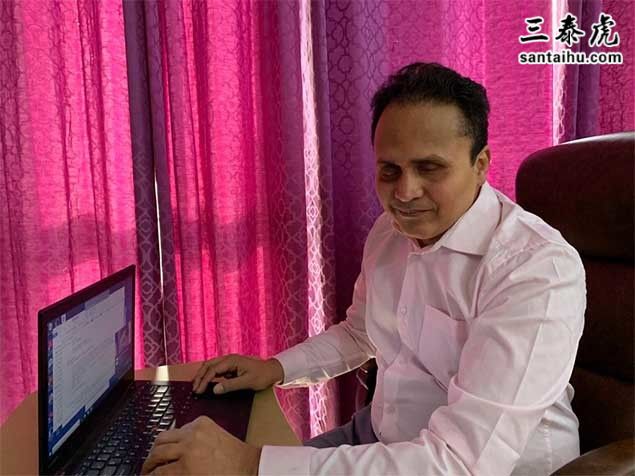这位印度人失明了也能编程,印网友:太厉害了
They can’t see, but they can write codes他们看不见,却能写代码 It's interesting to observe Alok Kaushik
They can’t see, but they can write codes
他们看不见,却能写代码
It's interesting to observe Alok Kaushik at work. You can see him typing on a keyboard but there’s no screen. There's no mouse either.
观察阿洛克·考希克工作挺有趣的,你可以看到他在键盘上打字,但没有屏幕,也没有鼠标。
Kaushik, a senior application developer with an e-commerce platform in the UK who works with complex software, is blind. So he has no use for a screen or a mouse. And he can code just as fast -- and well -- as the next guy who can see. Coming to his aid is an assistive software called 'screen reader' that converts written text into speech. That, essentially, has changed his world.
考希克是一名高级应用程序开发人员,在英国某电商平台工作,从事复杂软件的开发。他不需要屏幕和鼠标,也可以像其他人一样快速编码。帮助他的是一款名为“屏幕阅读器”的辅助软件,可以将书面文本转换成语音,这彻底改变了他的世界。
Thousands of miles away in Delhi, Pranav Lal, a cyber security expert with Vodafone, can code fluently in computer languages like Python, Java, C and C++. He, too, like Kaushik, is blind.
在千里之外的德里,沃达网络安全专家普拉纳夫•拉尔能用Python、Java、C和c++等计算机语言流利编码。和考希克一样,他也是个盲人。
“I started by writing simple programs to help me with my school work," Lal, 38, said. Today, he can write complex code and has developed a computer app – a speech recognition software -- for the visually-impaired.
38岁的拉尔说:“起初我写一些简单的程序来帮助我完成作业”。如今,他编写得来复杂的代码,并为视力受损的人开发一款电脑应用程序——语音识别软件。
Lal is an avid photographer and has adapted vOICe -- an AI tool that offers the blind the experience of live camera views through image-to-sound renderings -- for the Linux operating system. Images here are converted into sound by scanning them from left to right. It associates elevation to pitch and brightness to loudness. “I 'saw' the black hole using this tool,” Lal smiled.
拉尔是一名狂热的摄影师,为Linux操作系统改编了vOICe(一种人工智能工具,通过图像到声音的渲染,为盲人提供实时摄像机视图体验)。通过从左到右扫描图像,将其转换成声音。它把高度和音高、亮度和响度联系起来。“我用这个工具‘看到’了黑洞。”拉尔笑着说。
“Who would have thought that the visually-impaired could do coding,” said Arman Ali, executive director of National Centre for Promotion of Employment for Disabled People, an advocacy organisation. "But with technology, especially screen readers and artificial intelligence (AI), the visually impaired are being integrated into the mainstream workforce and are not limited to desk and accounting jobs anymore."
国家残疾人就业促进中心执行主任阿尔曼•阿里表示:“谁会想到视力受损的人也能编程呢?但随着科技的发展,尤其是屏幕阅读器和人工智能(AI)的开发,视障人士正在融入主流劳动力大军,不再局限于文书和会计工作。”
JAW (Job Access with Speech) and NVDA (NonVisual Desktop Access) are two popular screen readers while AI tools such as Microsoft’s See AI enables people with low or no eyesight to "experience" people, texts and objects.
JAW(语音工作访问)和NVDA(非可视桌面访问)是两种流行的屏幕阅读器,而像微软的See AI这样的人工智能工具可以让视力较低或没有视力的人“体验”人物、文本和物体。
"Technology is still limited to a small fraction of India’s blind population," Ali said. “We have to make it accessible to many more and for that we need the government to look at disability as a development issue and not a welfare issue.” He added, "For starters, the government should make it mandatory for all websites to be accessible with screen reader."
阿里称:“这种技术的使用仍然局限于印度盲人人口的一小部分。我们应该让更多的盲人用上这种技术”
Mohammad Afzal, 36, who lost his eyesight in a car accident when he was just 14, said programming for the blind these days "is no rocket science". Employed as a counsellor with Saksham, an NGO that works with the visually impaired in Delhi, he is busy teaching himself to code. "I want to get a degree in cyber security," he said. "I am learning Python, a programming language that’s similar to English and, therefore, easy to pick up.” Afzal added that he uses apps such as Ola, Swiggy, Google Maps, Twitter with ease on his smartphone using screen reader.
穆罕默德·阿夫扎尔今年36岁,14岁时在一场车祸中失明。他受雇于为德里视障人士服务的非政府组织Saksham,担任顾问,现在正忙着自学编码。“我想获得网络安全学位,”他说。“我正在学习Python,这是一种类似于英语的编程语言,很容易掌握。阿夫扎尔补充说,使用屏幕阅读器,在其智能手机上使用Ola、Swiggy、谷歌Maps和Twitter等应用程序非常方便。
To an untrained ear, the screen reader text sounds like a robot reading out the hurried disclaimer at the end of insurance TV commercial -- "Insurance is subject matter of solicitation…" -- but the speed can be adjusted and so can the characters that you want the reader to pick up. English is normally spoken at a speed of 120-150 words per minute. Screen reader can read up to 450 words per minute.
对于耳朵没有受过训练的人来说,屏幕阅读器听起来就像一个机器人在念电视保险广告结尾处的免责声明。但是速度可以调整,你想让阅读器读取的字符也可以调整。英语的语速通常为每分钟120-150个单词。屏幕阅读器每分钟最多可以读取450个单词。
Dinesh Kaushal, a 43-year-old NVDA development manager with Publicis Sapient, an MNC in Gurgaon, didn't have access to such technology while completing his school education, but he made the best use of what was available at the time.
43岁的迪尼什·考沙尔是古尔冈跨国公司Publicis Sapient的NVDA开发经理,他在读书期间没有接触过这种技术。
As a student in a special school he was told that he couldn’t study maths after Class 9 because of his impairment. He was born blind.
考沙尔生来双目失明,作为一名特殊学校的学生,迪尼什被告知,由于其缺陷,在9年级后他不能再学习数学。
Kaushal believes that students with visual impairment should be encouraged to study maths and english so that they too can get a chance to make a career in fields such as engineering and finance.
考沙尔认为,应该鼓励有视力障碍的学生学习数学和英语,这样他们也有机会在工程和金融等领域干出一番事业。
“I missed out most of the curriculum from classes 6-8 due to the lack of braille text books,” said Kaushal, who went back to studying mid-school math using audio books provided by the National Association of Blind while preparing for an MCA (masters of computer applications) exam. Today, he's a successful programmer with impressive credentials, like developing the first open source screen reader, Screen Access For all.
考沙尔说:“由于盲文课本的缺乏,我错过了6-8年级的大部分课程。”在准备MCA(计算机应用硕士)考试时,他用盲人协会提供的有声读物学习数学。如今,他是一个成功的程序员,拥有令人印象深刻的资历,比如开发了首款开放源码屏幕阅读器——人人都能访问屏幕。
While technology has made great strides in opening up the world for the blind, some blips still exist. For example, the coders we spoke to complained that many websites, including popular applications, are screen reader-incompatible.
尽管科技在为盲人打开世界的道路上取得了巨大进步,但仍存在一些问题。例如,我们采访的程序员抱怨许多网站,包括流行的应用程序,都是不兼容屏幕阅读器的。
“Most developers do not have a good understanding of web content accessibility guidelines. The end result is a software that cannot be used fully by screen reader. This could be significantly limiting, and we are forced to either move to alternative solutions or rely on sighted assistance,” said Kaushik, an IIT graduate who lost his eyesight in his 30s due to a rare genetic disease. Kaushal adds that including persons with disability in creating design and technology solutions for them can help in overcoming this challenge.
考希克毕业于印度理工学院,30多岁时因一种罕见的遗传病失明。
印度时报读者的评论:
外文:https://timesofindia.indiatimes.com
Keysman K• Unknown • 2 hours ago
Wonderful to see this information well done
很高兴看到这条新闻,做得好
Harry Tripathiy• 2 hours ago
If you have strong concentration power then everything comes easy
如果你有很强的专注力,那一切都会变得容易。
Abhishek Yadav• 2 hours ago
Kudos... Human can achieve anything..
致敬,人类无所不能。
Anonymous• bangalore • 2 hours ago
Making every adversity into an opportunity is the way forward for success.
把逆境都变成机遇是通往成功之道。
Fossil By Then• 3 hours ago
USA will welcome them with open arms..
美国将张开双臂欢迎他们。
Rajiv Tenguria Purohit• 3 hours ago
good that they still achieve things although they have tough hurdles. Good luck to them and everyone who doesn''''t let disability stop them from achieving their ambitions.
很好,尽管困难重重,他们仍然有所成就。祝他们好运
cool as cool• 2 hours ago
Coding is future.
编程成就未来
Mohammed Fayiz .v.k• 2 hours ago
Unbelievable,U r excellent
难以置信,你们太棒了。
Naveed Khan• Chennai • 3 hours ago
Amit Shah and Modi should learn Coding. They will need a Job very soon.
阿米特·沙阿和莫迪应该去学编程。他们很快就得换工作了。
Naveed Khan• Chennai • 3 hours ago
Modi should be Coder, he is mentally a blind person
莫迪应该去当程序员,他是个精神盲人
SN Murthy Kurella• Muscat • 3 hours ago
Simply superb, great
非常棒,太厉害了
Sourav Deep• 3 hours ago
It''s a really good inspiration..
真的非常励志
Eranki Ravi• 3 hours ago
Inspirational article
励志文章
MUsu nayak• 3 hours ago
We indeed have more than 5 senses.. Hats off to these gentlemen
我们确实有第六感。向他们致敬
版权声明
我们致力于传递世界各地老百姓最真实、最直接、最详尽的对中国的看法
【版权与免责声明】如发现内容存在版权问题,烦请提供相关信息发邮件,
我们将及时沟通与处理。本站内容除非来源注明五毛网,否则均为网友转载,涉及言论、版权与本站无关。
本文仅代表作者观点,不代表本站立场。
本文来自网络,如有侵权及时联系本网站。
阅读:
-
1
चाइना में रेडी और ठेले Local shops in china || L...
- 2
- 3
- 4
- 5
- 6
- 7
- 8
- 9
- 10
-
1
चाइना में रेडी और ठेले Local shops in china || L...
- 2
- 3
- 4
- 5
- 6
- 7
- 8
- 9
- 10











